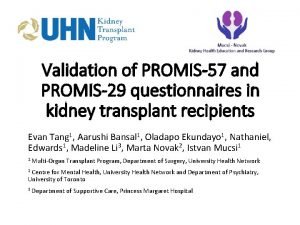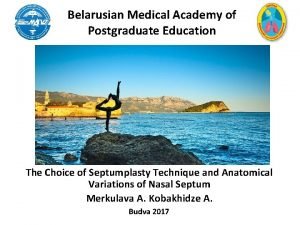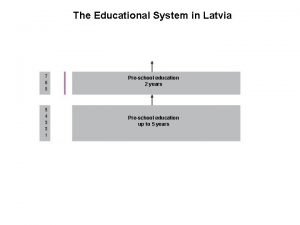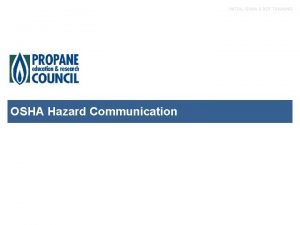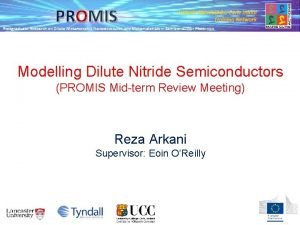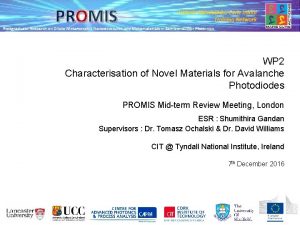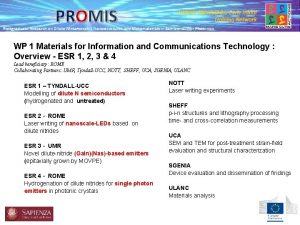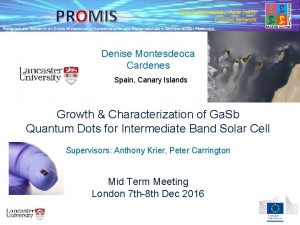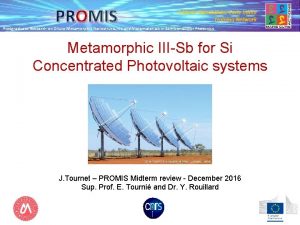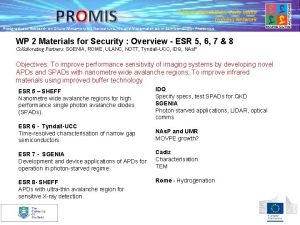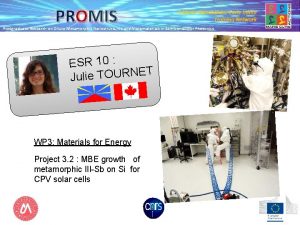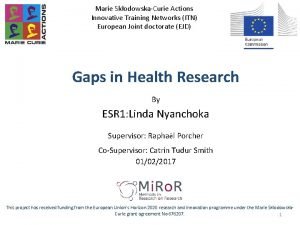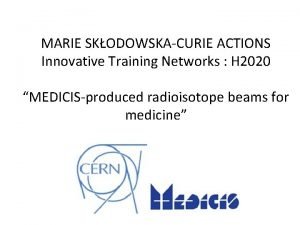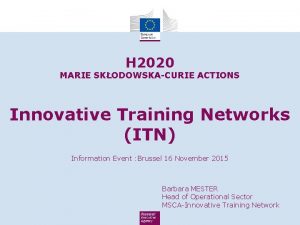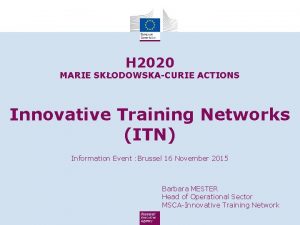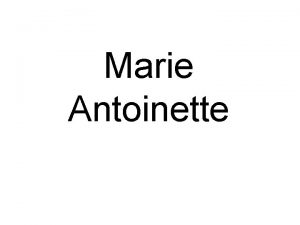PROMIS A Marie SkodowskaCurie Initial Training Network Postgraduate















- Slides: 15

PROMIS A Marie Skłodowska-Curie Initial Training Network Postgraduate Research on Dilute Metamorphic Nanostructures and Metamaterials in Semiconductor Photonics In. Sb Quantum Dots for High Efficiency mid-IR LEDs WP 4: Materials for Environment Applications E. Repiso, P. Carrington, A. R. J. Marshall, Q. Lu and A. Krier Cadiz PROMIS Workshop 18 -20 May 2016

Outline • Challenges in the Mid-infrared; 3. 3 and 4. 2 μm • Proposal: In. Sb Quantum Dots • MBE growth • PL and EL studies • Summary 2

Challenges in the Mid-infrared • Lattice matching of the active region • No Semi-insulating substrates CB • Inadequate electrical confinement; small band offset • Imbalance in the DOS • Leakage current; surface and bulk • Inter-valence band absorption • Auger - CHCC Eg 1 2 HH 1’ LH - CHSH • Shockley-Read-Hall; native defects or dislocations • Extraction efficiency (~1%) Δ 0 SO 3

Challenges in the Mid-infrared • Lattice matching of the active region • No Semi-insulating substrates CB • Inadequate electrical confinement; small band offset • Imbalance in the DOS 3’ 1 3 • Leakage current; surface and bulk • Inter-valence band absorption • Auger Eg 2 HH Δ 0 - CHCC LH - CHSH • Shockley-Read-Hall; native defects or dislocations • Extraction efficiency (~1%) SO 3

Approaches: Quantum Dots DH QW QD • δ-like density of states; more confinement. • Temperature insensitive. • Avoid lattice mismatch. • Have shown promising results at shorter wavelengths. 4

Approaches: In. Sb QDs in In. As III-V band line-ups X • Self organisation is possible due to large enough lattice mismatch, Da/a = 6. 5% Al. Sb • Compresive strain. -0. 41 • Type-II broken gap Band Line-up => Reduced Auger recombination => Higher emission efficiency at room temperature in e. V 0. 78 77 K Ga. Sb 0. 23 In. Sb -0. 17 -0. 03 0 In. As -0. 59 EC EV In. Sb a ~ 6. 1Å 910 me. V 415 me. V In. As Vurgaftman & Meyer, JAP(2001) 185 me. V DEC 680 me. V - + 6. 47Å + In. As Su-Huai Wei, Zunger A. , PRB (1995) EC EV 5

Stranski-Krastanov growth of In. Sb QDs • In and Sb are large atoms that behave as surfactants. In. Sb has a low bond energy – high surface mobility of atoms-. • Promote 2 D growth rather than 3 D. • Tendency to form large clusters of islands. • Low density of dots. In. Sb In. As Increasing strain In. Sb In. As 2 D Layer growth followed by 3 D island growth. Critical thickness = 1. 7 ML Veeco GENxplor 6

In. Sb submonolayer QDs In. Sb QDs within ultra-thin In. Sb layers (0. 5 -0. 9 ML) in In. As have been formed by exposing the growth surface to a Sb flux exploiting an efficient As-Sb exchange: Solov’ev 2005 (MBE) Sb Flux As rich surface In. As As – Sb exchange In. As 7

In. Sb submonolayer QDs In. Sb QDs within ultra-thin In. Sb layers (0. 5 -0. 9 ML) in In. As have been formed by exposing the growth surface to a Sb flux exploiting an efficient As-Sb exchange: Solov’ev 2005 (MBE) Sb Flux As rich surface In. As Dense array of In. Sb islands partly covering the surface In. As 7

Extra In. Sb insertions • To grow larger QDs at high growth temperatures – reduce Sb segregation, better quality material and to avoid long growth interruptions. • A In. Sb deposition in MEE mode is used following the Sb exchange. • In the insertions thicker than 1 ML, PL intensity drops drastically: growth of relaxed islands. Intensity (a. u. ) In. As Single Sb exchange + MEE 8

MBE growth and design of In. Sb/In. As QDs Samples for PL studies 17. 8 nm-In. As barriers In. Sb QDs (0. 8 ML) 9

Temperature dependent PL Temperature dependence: The characteristic temperature Tc = 109± 2 K 10

In. Sb QDs LEDs 0. 7 ML In. Sb QD, 10 Sheets / 17 nm barriers n-In. As n+ In. As Al. Ga. As. Sb electron blocking barrier (30 nm) p+In. As 0. 5 µm 0. 3 µm 0. 5 µm 11

Summary • Successful growth of high density (1· 1012/cm 2) In. Sb QDs in In. As with excellent crystalline quality and low defect density. • Bright PL up to room temperature with superior quenching compared to bulk In. As. • Room temperature LEDs with dominant radiative recombination, peak at 3. 8µm. • Demostrated the potential of type II In. Sb/In. As QDs for mid-infrared photonic devices. 12

PROMIS A Marie Skłodowska-Curie Initial Training Network Postgraduate Research on Dilute Metamorphic Nanostructures and Metamaterials in Semiconductor Photonics Thanks for your attention
 Postgraduate training authorization letter
Postgraduate training authorization letter Promis 57
Promis 57 Promis domains
Promis domains Un templu sfant versuri
Un templu sfant versuri Kramer's postgraduate resocialization model stages
Kramer's postgraduate resocialization model stages Undergraduate graduate postgraduate
Undergraduate graduate postgraduate Difference between postgraduate and undergraduate
Difference between postgraduate and undergraduate Difference between postgraduate and undergraduate
Difference between postgraduate and undergraduate Susi grant limits
Susi grant limits Clinical governance postgraduate
Clinical governance postgraduate Belarusian medical academy of postgraduate education
Belarusian medical academy of postgraduate education What is postgraduate
What is postgraduate Alexmed postgraduate
Alexmed postgraduate Carter review of initial teacher training
Carter review of initial teacher training Osha hazard communication initial training
Osha hazard communication initial training Datagram approach
Datagram approach

